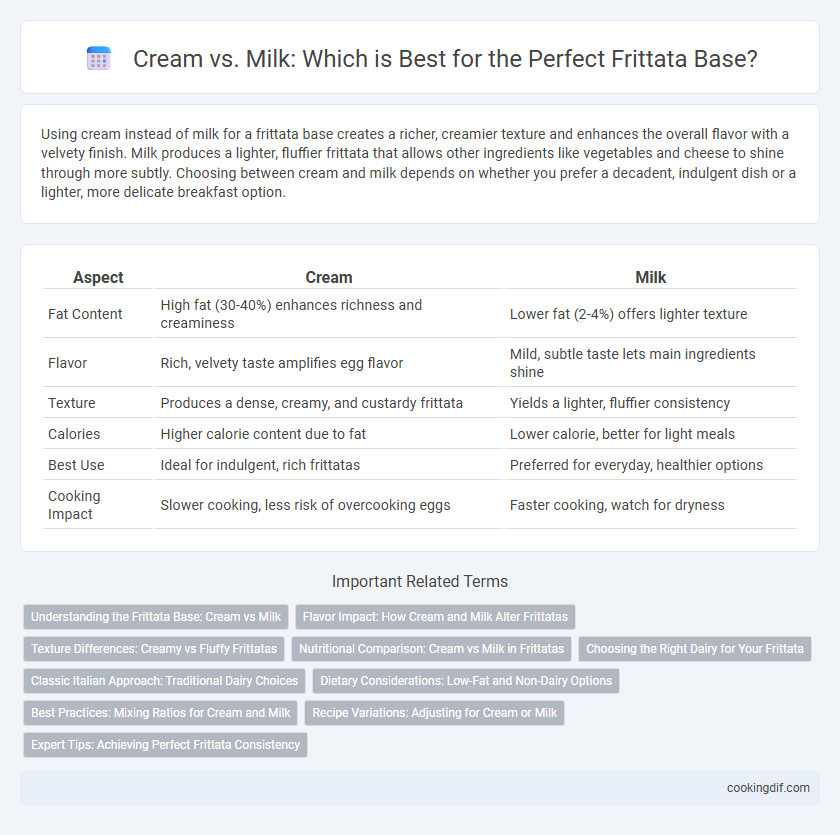Using cream instead of milk for a frittata base creates a richer, creamier texture and enhances the overall flavor with a velvety finish. Milk produces a lighter, fluffier frittata that allows other ingredients like vegetables and cheese to shine through more subtly. Choosing between cream and milk depends on whether you prefer a decadent, indulgent dish or a lighter, more delicate breakfast option.
Table of Comparison
| Aspect | Cream | Milk |
|---|---|---|
| Fat Content | High fat (30-40%) enhances richness and creaminess | Lower fat (2-4%) offers lighter texture |
| Flavor | Rich, velvety taste amplifies egg flavor | Mild, subtle taste lets main ingredients shine |
| Texture | Produces a dense, creamy, and custardy frittata | Yields a lighter, fluffier consistency |
| Calories | Higher calorie content due to fat | Lower calorie, better for light meals |
| Best Use | Ideal for indulgent, rich frittatas | Preferred for everyday, healthier options |
| Cooking Impact | Slower cooking, less risk of overcooking eggs | Faster cooking, watch for dryness |
Understanding the Frittata Base: Cream vs Milk
Choosing cream over milk for a frittata base results in a richer, more velvety texture due to the higher fat content, which enhances the dish's flavor and moisture. Milk provides a lighter, airier consistency, allowing the eggs to set with a delicate firmness without overwhelming richness. Understanding the differences in fat percentages and texture outcomes between cream and milk helps tailor the frittata to desired taste and mouthfeel preferences.
Flavor Impact: How Cream and Milk Alter Frittatas
Cream adds a rich, velvety texture and intensifies the buttery flavor of a frittata, resulting in a more luxurious mouthfeel. Milk produces a lighter, more delicate frittata that allows the flavors of vegetables and cheese to shine through without overpowering. Choosing cream or milk directly influences the final texture and taste, with cream delivering decadence and milk offering subtlety.
Texture Differences: Creamy vs Fluffy Frittatas
Using cream as the liquid base in a frittata results in a rich, creamy texture with a denser, custard-like consistency, enhancing the dish's moisture and indulgence. In contrast, milk produces a lighter, fluffier frittata with a tender crumb and a more aerated structure, ideal for a delicate mouthfeel. Choosing between cream and milk directly influences the texture outcome, balancing richness against lightness to suit personal preference.
Nutritional Comparison: Cream vs Milk in Frittatas
Using cream as a base in frittatas significantly increases the fat and calorie content compared to milk, enhancing richness but also adding saturated fats. Milk provides a lighter option with fewer calories and less fat, making it suitable for those seeking a healthier alternative without sacrificing protein. The choice between cream and milk alters not only texture and flavor but also impacts nutrient density and overall nutritional balance of the dish.
Choosing the Right Dairy for Your Frittata
Cream provides a richer, denser texture for frittatas, yielding a custard-like consistency, while milk results in a lighter, fluffier base with less fat content. Whole milk or 2% milk are ideal for balancing moisture and tenderness without overpowering the egg's flavor. Selecting the right dairy depends on your preferred texture and richness, with cream enhancing decadence and milk offering a subtle, airy finish.
Classic Italian Approach: Traditional Dairy Choices
The classic Italian approach to frittata bases favors using whole milk for a lighter, more delicate texture that highlights the eggs' natural flavor, aligning with regional culinary traditions. Cream is less commonly used in traditional Italian recipes because it can overpower the frittata, making it richer but masking subtle flavors. Opting for whole milk maintains the authentic balance and ensures a tender, fluffy frittata consistent with Italy's time-honored methods.
Dietary Considerations: Low-Fat and Non-Dairy Options
Using milk instead of cream in a frittata base significantly reduces fat content, making it a healthier choice for those seeking low-fat diets. Non-dairy alternatives like almond or oat milk provide lactose-free options while maintaining a creamy texture and flavor profile. These substitutions cater to dietary restrictions including lactose intolerance and vegan preferences, ensuring the frittata remains accessible without compromising taste or consistency.
Best Practices: Mixing Ratios for Cream and Milk
For a creamy and fluffy frittata base, the optimal mixing ratio is typically 1 part cream to 2 parts milk, balancing richness and lightness. Using heavy cream alone can make the frittata dense and overly rich, while milk alone may result in a less creamy texture and dryer consistency. Experimenting with whole milk and 35% cream in these proportions enhances the custard-like quality and holds the eggs' structure perfectly during baking.
Recipe Variations: Adjusting for Cream or Milk
Using cream as the base for a frittata results in a richer, creamier texture with a velvety mouthfeel, while milk offers a lighter, fluffier consistency. Recipes using cream typically require fewer additional fats, as cream's higher fat content enhances the overall richness. Adjusting from milk to cream in frittata recipes may necessitate reducing other dairy or oil components to maintain balance and prevent excess heaviness.
Expert Tips: Achieving Perfect Frittata Consistency
Experts recommend using cream instead of milk for a richer, silkier frittata texture due to its higher fat content, which enhances moisture retention and flavor depth. Milk can result in a lighter, fluffier base but may cause the frittata to become drier or less cohesive when cooked. Balancing the liquid ratio precisely, typically around 1/4 cup of cream per 6 eggs, ensures optimal consistency without compromising structural integrity.
Cream vs Milk for Frittata Base Infographic

 cookingdif.com
cookingdif.com